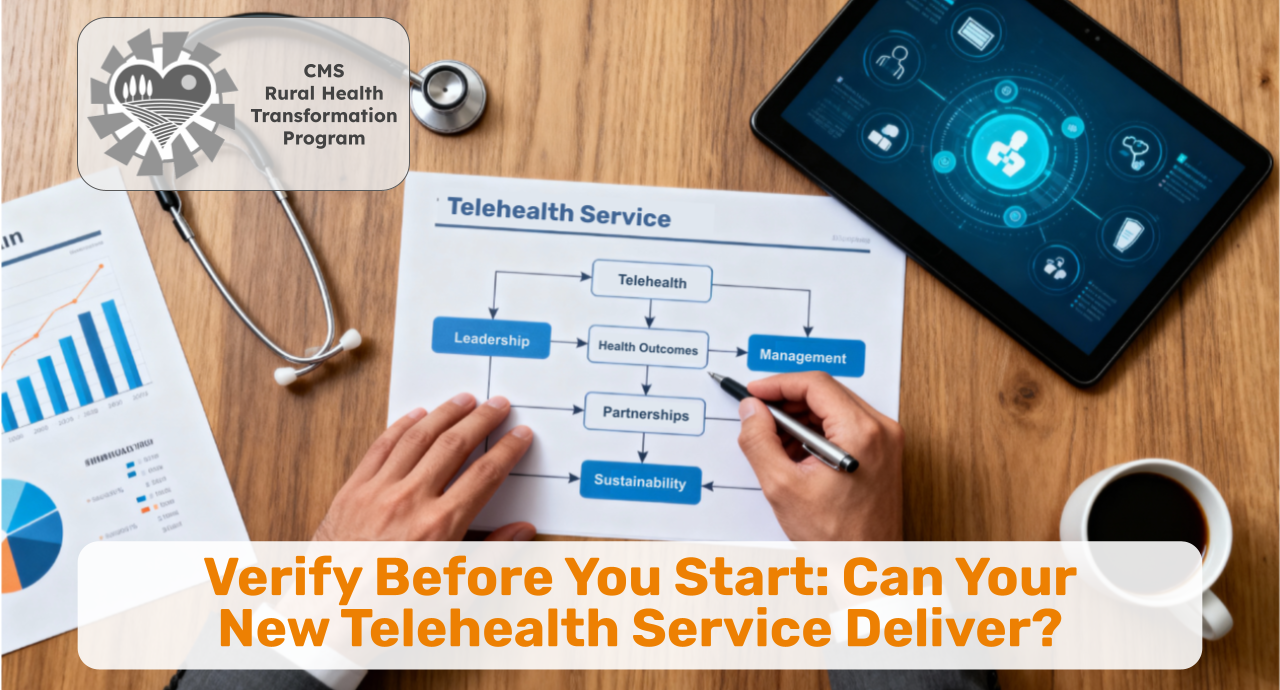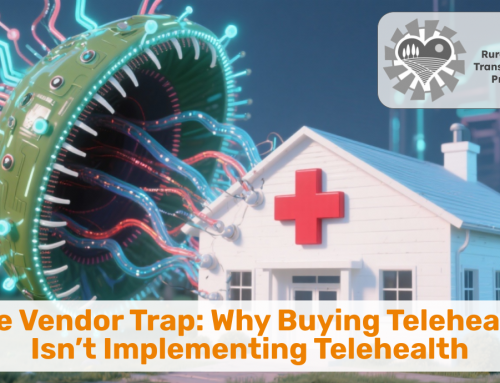Launching a telehealth service is easy.
Designing a telehealth service that creates lasting strategic, financial, and clinical value? That’s the hard part.
As states participating in the Rural Health Transformation Project (RHTP) begin identifying digital health solutions for their communities, many risk skipping the critical step that determines whether those services will actually deliver: Service Verification.
Verification is more than due diligence — it’s a discipline. Verification, an engineering principle, ensures that the envisioned solution meets all of the critical needs.
Verification is how healthcare organizations pressure-test whether a proposed telehealth service is worth investing in, capable of scaling, and viable in the long run. And it’s the only way to avoid wasting RHT dollars on services or solutions that sound good in a sales presentation (or even a reference case study) but collapse under the weight of misalignment, unrealistic ROI, or clinical disengagement.
I’ve said it before: to launch is not enough. And telehealth services or solution vendors won’t do this step for you — it’s not their goal. Only the organization itself, with full understanding of its strategy, operations, and care delivery realities, can determine if a service is truly fit for purpose.
In this 9th article focused on providing guidance to the teams managing their state’s RHT program I outline a practical framework — used by leading health systems — to verify telehealth services across three essential lenses: Strategic, Financial, and Clinical.
It’s how smart organizations answer one deceptively simple question before scaling: Do we have a winner?
Why Is Service Verification Important?
In the rush to innovate, it’s easy to fall for vendor services and solutions that promise everything yet, oftentimes deliver little in the long run. This is not necessarily the vendors’ fault – but rather an oversight by the people managing the implementation and integration of the vendor offering.
This is exacerbated in rural markets, where the needs are urgent, implementation talent is scarce, and the margin for error is slim. Without structured verification, even well-designed solutions can lead to wasted capital, fragmented care models, and staff frustration.
Verification ensures your organization or program is investing its scarce resources into solutions and services that align with your goals, generate measurable value, and improve patient care. It also builds the internal alignment needed to drive change across clinical, operational, and executive teams.
When does verification matter most?
-
Prioritizing services for RHTP funding or internal investment
-
Choosing a new telehealth platform or telehealth services vendor
-
Scaling a proof-of-concept into a full program
-
Revisiting a stalled initiative that never gained traction



The Three-Lens Approach to Verifying Value
1. Strategic Case: Does It Advance What Matters Most?
Verification starts by asking: How will this telehealth service advance our current strategic objectives? A high-value solution will move the needle on multiple fronts —., access, workforce sustainability, equity, competitive position — not just one.
This lens helps surface whether the service is a one-trick pony or a bowling ball that can knock over multiple strategic goals. You’re looking for solutions that:
-
Align with 2–3 of your top strategic priorities
-
Fit within broader organizational initiatives
-
Have leadership and clinical buy-in for the change required
Because If the service doesn’t advance your strategy, why invest at all?
2. Financial Case: Will It Deliver ROI — or Drain Resources?
It’s not just about cost — it’s about value. That means looking beyond license fees to assess total cost of ownership and evaluating the full return potential beyond reimbursement, including new revenue streams, operational savings, market share protection, and staff retention.
Ask:
-
What are the direct and indirect costs over 1–3 years?
-
What measurable financial benefits can we expect—and when?
-
How does this compare to other ways we could invest these dollars?
Too many services survive pilot funding but collapse under the weight of hidden costs and unclear payback. Verification makes that visible — before it becomes painful.
3. Clinical Case: Will It Actually Improve Care?
Every healthcare initiative must ultimately serve the patient. Every telehealth service is ultimately successful because of the clinicians that deliver the service. That’s why clinical validation and buy-in is non-negotiable. Engage frontline clinicians as early as possible to identify and define:
-
How the service improves clinical efficiency, outcomes, safety, or engagement
-
What workflows will change — and whether the change will be sustainable
-
Whether there’s a clear clinical champion ready to drive adoption
If the service doesn’t make care demonstrably better — and clinicians aren’t on board — it won’t stick.
Why Telehealth Vendors Can’t Do This for You
Most telehealth solutions and services vendors can’t tell you how well their service fits your strategy, delivers ROI in your context, or works in your workflows. That’s not a knock — it’s just reality. They don’t have access to your operating model, strategic plan, or frontline feedback loops.
Teams that launch successful, sustainable telehealth services work with telehealth implementation experts — experienced professionals who understand clinical workflows, change management, training design, performance tracking, and more from the inside out. That’s where experience makes all the difference: not in choosing the flashiest solution, but in ensuring it actually works in practice.
What vendors can provide are inputs: functionality, implementation support, case studies. But only you and partners representing your interests can connect those dots into a value case. Relying on vendor projections to justify investment is like outsourcing your compass — it points wherever the salesperson wants it to.
Service verification is how you take back control of your own decision-making.
Getting to “Yes” (or “No”) with Confidence
Once you’ve built out all three cases — strategic, financial, and clinical — you’re ready to make an informed, cross-functional decision. That might mean moving forward with funding. It might mean redesigning. It might mean looking for a better service.
The point is not to slow things down. It’s to focus your momentum on services that are worth the effort. Because once you’re live, unwinding a poor decision is far more costly than verifying it upfront.
Final Thought: Make Verification Standard, Not Optional
Especially in the context of the Rural Health Transformation Program, where demonstrable and sustainable success in the forms of utilization and outcomes will come under close scrutiny, service verification should be a default part of your service selection, vendor selection and implementation process.
It’s not a hoop to jump through — it’s how you ensure your next telehealth service actually delivers.
Do you agree? Disagree? Where have you seen the three lenses of verification being applied successfully? Let me know.








To receive articles like these in your Inbox every week, you can subscribe to Christian’s Telehealth Tuesday Newsletter.
Christian Milaster and his team optimize Telehealth Services for health systems and physician practices. Christian is the Founder and President of Ingenium Digital Health Advisors where he and his expert consortium partner with healthcare leaders to enable the delivery of extraordinary care.
Contact Christian by phone or text at 657-464-3648, via email, or video chat.






